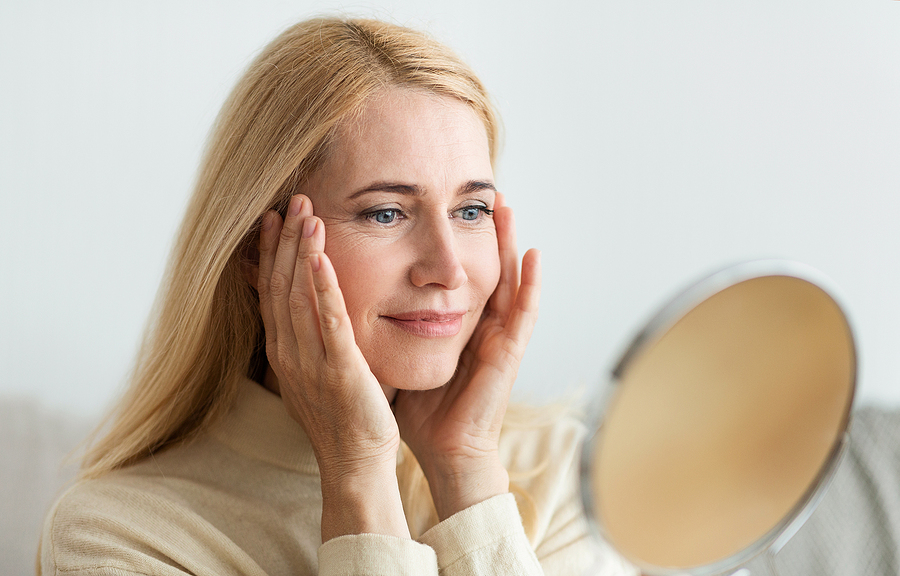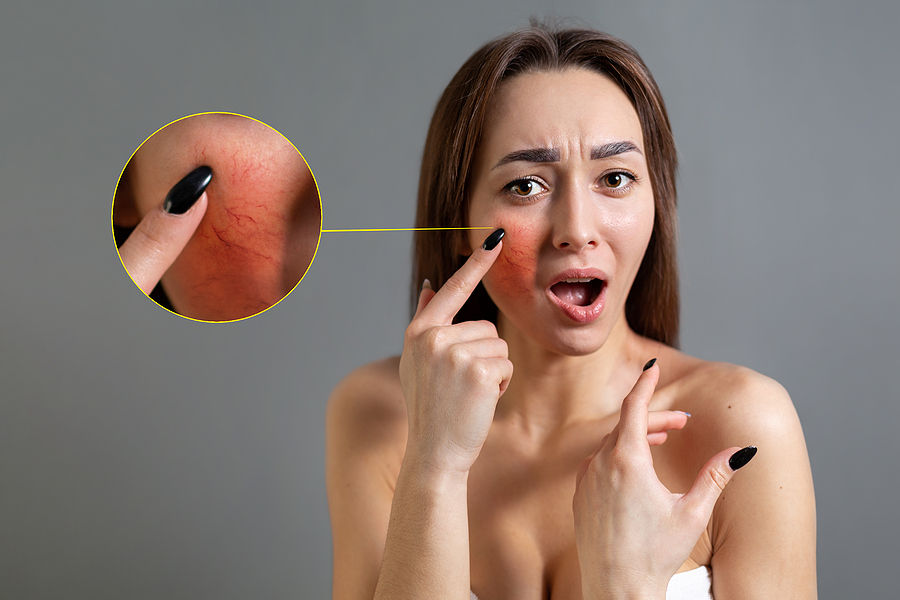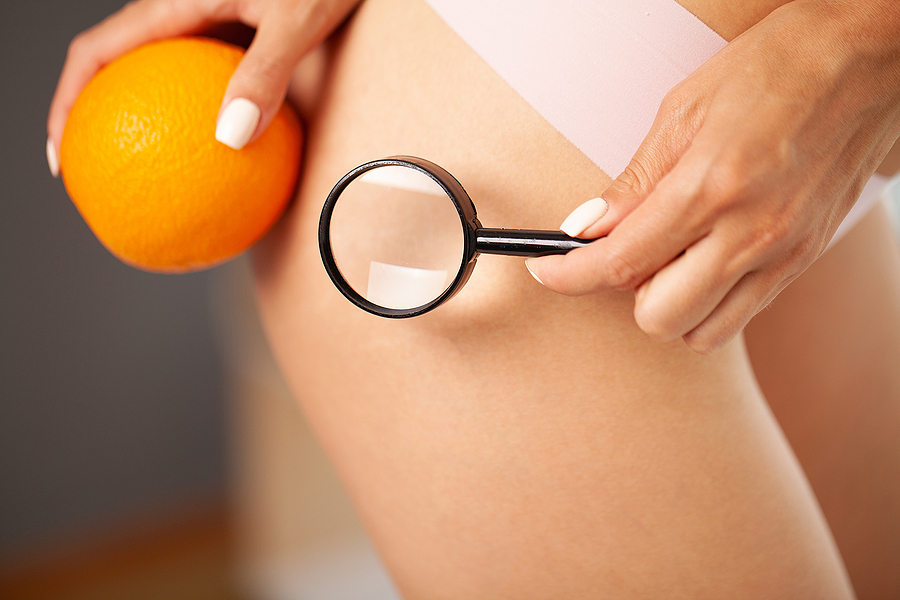Updated 9/20/2020
People ask me all the time how I keep my skin looking so smooth and healthy. They tell me they’ve tried every product they could find to try and get their skin to stay smooth and clear, to no avail. It’s great to hear that my natural approach is working, and I’m excited to share what I know about healthy skin with other women.
I’ve emphasized the idea that you do NOT need to accept skin problems as an unavoidable side effect of getting older. While there are certainly changes that occur as we age, there are many natural ways to protect your skin and keep it looking great, whatever your age!
Previously, I’ve discussed inflammation and the impact it has on healthy skin. Now, let’s talk a little more about the impact of antioxidants on free radicals, how diet and emotions play a role, and the danger of many beauty products. Then, I’ll outline some practical suggestions on how to naturally combat inflammation to keep your skin smooth, clear and healthy.
Antioxidants — at the defense of healthy skin
In my first article, I talked about free radicals (oxygen molecules missing an electron) that fuel inflammation and wreak havoc on the skin.
To counteract free radicals, our immune system relies on certain nutrients that defend the cells from free radicals. These cell-scrubbers are called antioxidants, most of which are plant derived. Antioxidants neutralize free radicals and quench minor inflammation by sacrificing one of their electrons without adverse effect.
Since free radicals are inescapable, we must have a constant supply of antioxidant nutrients to keep our skin cells healthy. In addition, antioxidants may actually encourage the “fix-it” enzymes in our cells to repair damage. Our cells have a wonderful ability to heal themselves, but this mechanism works less efficiently as we get older — perhaps due to damaged mitochondrial function.
The major antioxidants are:
- Vitamin C (found in plants and fruits)
- Vitamin E, specifically high-potency tocotrienols (HPE; good sources are rice bran oil and palm fruit oil)
- Coenzyme Q-10 (found naturally in our cells but decreasing after age 20)
- Alpha-lipoic acid (ALA; found in plant and animal sources)
- Dimethylaminoethanol (DMAE; found in fish)
- Carotenoids (phytonutrients found in the red, yellow and orange flesh of plant leaves, flowers and fruit)
- Flavonoids (found in green tea, soy isoflavones and red wine, among other food sources)
When we don’t have enough antioxidants on board and free radicals get the upper hand, they damage the deep workings of the skin tissue — the fibroblast cells that generate collagen and elastin, two types of protein that form the connective tissue that keeps skin firm, clear and supple. This destructive process is called oxidation. Think of the way an apple turns brown when it’s exposed to the air and you’ll get the picture.
Unfortunately, the world we live in now (especially during a pandemic and major civil unrest) promotes internal inflammation and early aging. Even without those major societal stressors, life is filled with physical and psychological stress. Women are caring for both children and aging parents, all while trying to balance a career and keep a household together.
Levels of free-radical-producing substances have exploded. At least 80,000 industrial chemicals are registered for use in the US and more are approved every day. At the same time the quality of our nutrition has been steadily eroding. Faced with such a huge increase in oxidative load and more limited support, it’s natural that our bodies become inflamed internally and end up showing the wear and tear externally on our skin.
Skin care and your diet
The first place to start improving the health of your skin is your diet. Following a cleansing, anti-inflammatory diet, will help you understand how powerfully your diet relates to the condition of your skin. We’ll get to the specifics on how to do so in a minute. Once you see the difference, you can continue to make positive food choices a way of life.
And while you are cleaning out your insides, you should also check into your emotions — because your feelings can be as inflammatory as dietary and environmental factors.
Emotions and skin
Skin is a fantastic communicator — often revealing our unspoken emotions to the world. Who hasn’t heard of turning crimson in anger or blanching with fear? Why does stress cause some women to break out in hives and others in pimples? The answer lies in the body’s individual response to inflammatory stressors. If you are a highly emotional person, or conversely, if you bury your emotions, your skin tends to expose your true nature — perhaps more than you realize.
The work of two Japanese researchers, Makoto Hashiro and Mutsuko Okumura, illustrates this point They have published studies in the Journal of Dermatological Science showing that eczema (also called atopic dermatitis) occurs more frequently in people prone to anxiety and depression than the general population.
But even on an everyday level, your personal tendencies are manifested by the state of your skin. In the Ayurvedic tradition, there are three constitutional principles, or doshas, at work in the body. Generally speaking, one influence predominates for each of us and governs our body type. Each type is defined by a certain metabolic predilection (fast, slow, moderate) that influences health and emotional outlook. Interestingly, each body type, as well as its corresponding emotional tendencies, is characterized by a certain kind of skin (dry, ruddy, oily).
It stands to reason, then, that internalizing anger and stress may have as much to do with chronic breakouts as excessive sebum (oils in the skin). Some practitioners look at acne as a buildup of subterranean emotional issues that need to “burst” out. As we learn more about this powerful connection, perhaps stress-relieving alternative techniques such as biofeedback and meditation will be used as often as we use creams and pills to treat chronic skin disorders.
And speaking of creams, it is useful to consider the products you apply to your skin every day when you think about what could be causing skin-damaging inflammation in your body.
The hidden hazards in beauty products
Synthetic additives in cosmetics are largely unregulated by the FDA, yet many of these compounds have been proven to disrupt endocrine function, interfering in the metabolism of sex hormones. This can seriously impair fertility and might contribute to breast cancer, especially in the subset of the population that is more sensitive.
Many of the chemicals in cosmetics and creams may, in and of themselves, breed free radicals (and the resulting inflammation), contradicting their claims of being youth-enhancing. Even more troubling is the preponderance of petroleum-based chemicals in toiletries and cosmetics. One ubiquitous category, called phthalates, has recently been reviewed by an expert panel that found several potential health risks associated with exposure. Phthalates are everywhere, including cosmetics and lotions. The best way to reduce your exposure is to eat organic foods.
Additionally, few studies have looked at the dangerous cumulative and inflammatory effects of combining so many different skin products over a lifetime — or how those chemicals interact with all the other chemicals we’re exposed to. The average woman uses 5–12 different products on her skin — an untested chemical soup — each and every day. If one of my patients has a skin or hair concern, the first thing I tell her is to go home and throw out the products that contain synthetic chemicals (which usually means all of them).
Luckily, a growing awareness of this problem has led to a number of reasonable natural alternatives. The Body Shop, Burt’s Bees, Kiss My Face, and Avalon Natural Products have all agreed to be free of chemicals that are suspected of causing cancer, mutation or birth defects. The Environmental Working Group keeps a comprehensive database of skin care and beauty products that are free from harmful chemicals. It’s a great resource well worth bookmarking in your browser.
Anti-aging Holistic Skin Care
When you look closely at the various factors that influence your skin, it’s not surprising to find that most over-the-counter skin care products fall short of what they promise. Caring for your skin means caring for yourself, from the inside out.
My approach to skin care has two primary goals: 1) to soothe inflammation; and 2) to support your body’s natural anti-aging and healing properties. Here are some great ways to get started
Diet:
- Eating whole, organic foods with relatively low glycemic index values. Increase your intake of antioxidant-rich foods, such as colorful vegetables, berries, fruits and green tea.
- Drink at least 8–10 eight-ounce glasses of filtered water a day.
- Take a medical-grade nutritional supplement rich in calcium, magnesium and essential fatty acids. EFA’s exert an overall anti-inflammatory effect and help keep skin supple and moisturized at its deepest layer.
- Talk to your practitioner about DMAE supplements, both ingestible and topical. Some women do find DMAE causes redness and irritation. Other antioxidants may be ingested as supplements, but you need to do so under professional guidance.
- Consider taking a probiotic supplement daily to boost beneficial anti-inflammatory flora in the digestive tract.
- Avoid or limit sugar, caffeine, artificial sweeteners, food additives, trans fats and simple carbohydrates, especially if you have acne or rosacea. These are highly inflammatory to many people.
- Try to cleanse and rest your system a few times a year by practicing regular detox. Your body has a natural detoxification process, and I don’t advocate for harsh detox plans, but there are some that will gently help your body along. The Fat Flush Plan by Louise Gittleman and Frank Lipman’s Total Renewal are two good places to start. Otherwise, try eating only organic, washed fruits and vegetables for a few days and drink lots of filtered water (this is easiest in the spring and summer).
Lifestyle:
- If you are smoking, try to quit. Just one cigarette creates billions of harmful free radicals. Smoking can add ten years to your skin’s appearance.
- Exercise daily to reduce stress, support your body’s natural detoxification, and reduce inflammation.
- Throw out unnecessary products in your medicine cabinet and cupboards and any products that contain toxic additives or the mystery ingredient “fragrance”. If they won’t tell you what’s in it, chances are it’s not good for you.
- Examine your hidden emotions or emotional tendencies. If you think you may be harboring some unexpressed emotions, find a safe place to free them. Negativity has a way of manifesting in the skin. Emotional Freedom Techniques (EFT) is a wonderful method of releasing pent-up feelings of anger, anxiety, and fear.
- Find stress relief in the form of meditation, a daily gratitude practice, deep breathing and mindfulness exercises. If you need inspiration, look at the skin of most yoga teachers!
Skin care regime:
- Cleanse your skin morning and night with a gentle, soap-free cleanser. Do not scrub! Scrubbing actually breaks capillaries and damages cell tissue, which encourages invasive bacteria. Use a wad of cotton or your fingertips. Rinse thoroughly with clean, tepid water and dry gently.
- Try to keep your hands off your skin unless they are clean; your fingers can transmit oil and bacteria. During the pandemic, we’ve all worked hard not to touch our faces — extend that to the rest of your body too! Don’t pick blemishes — it damages cell tissue and permanently widens pores.
- Use an all-natural exfoliant 2–3 times a week to remove excess dead skin cells.
- Moisturize and protect with an all-natural moisturizer/sunscreen. Use sunscreen with an SPF of 30 when out in the sun for more than 15 minutes. Find a product that contains valuable topical antioxidants like co-Q10, ALA and vitamin C ester. Dr. Hauschka and USANA offer reliable, professional nontoxic skin care lines. Dr. Perricone and Obagi are other proprietary programs with excellent results, though the products are not all-natural.
- Discuss the usefulness of a regular facial peel with a responsible aesthetician. Glycolic or hydroxy (alpha or beta) peels can help the texture and appearance of surface skin while stimulating new cell growth underneath.
- Use natural cosmetics. Aveda, Burt’s Bees and The Body Shop have branched out into a growing array of cosmetics. You should be able to replace your favorite lipsticks, mascara and foundation with chemical-free alternatives. The EWG database can help you find a better option. Your skin will thank you!
Additional measures:
If you have made all the positive diet and lifestyle changes to support your glowing health (and skin) but still feel your outside doesn’t reflect your inside, there are other steps you can take.
- Investigate dermabrasion to resolve deep scarring and imperfections. Talk to a professional aesthetician about pulsed laser technology (IPL) or other laser therapies for unwanted hair, sun damage, spider veins, rosacea and other discoloration.
- If your acne is not improving, go ahead and use antibiotics. Just be sure to support your body through proper supplements and diet, and discontinue the antibiotics as soon as possible. Talk to your medical professional about what will work best for you.
- Look into a “natural facelift” through acupuncture. Acupuncture works by increasing blood flow and muscle tone, as well as by soothing inflammation. This is an amazing technique that works!
And remember — the media is not reality. Magazine pictures are retouched (and sometimes drastically altered), celebrities have teams of makeup artists and other experts at their disposal. Don’t strive for an unrealistic perfection.
When you look in the mirror, see beyond the minor imperfections and laugh lines to the glowing spirit that lies within. Honor yourself and the skin you were born in by taking the best care of yourself that you can. You and your skin deserve it!







